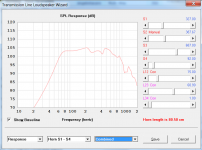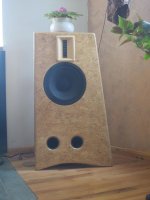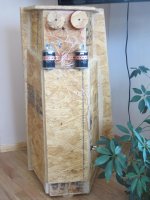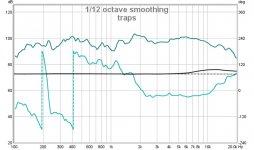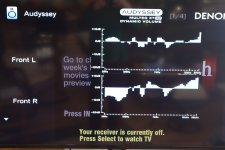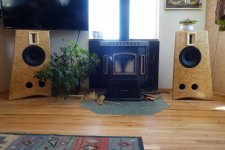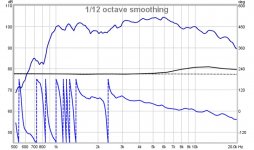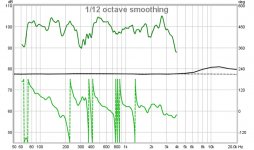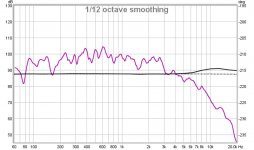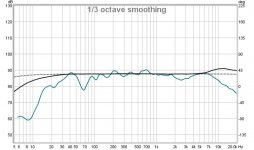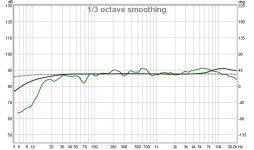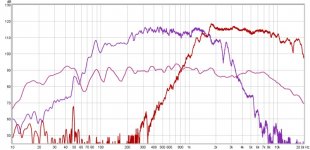Hi,
After reading a few thousand post's on this forum. I was panning to build a FLH for for the beyma that would integrate nicely with the sub I designed and built.
The Crawler, A Floor joist horn build
But as the design evolved it became apparent that I would have to build an addition first, so in horn resp i came up with this.
Since this is my first two way speaker design decided to build a prototype cabinet, so that I could experiment with port's, waveguides, crossover's, REW etc.
Here is a couple of pics
Honestly, some of the ugliest thing I have ever created
But also the most beautiful sound, they draw you right in and captivate you
first in room measurement at 1 meter.
Audessy correction
I thought for sure I would be spending the next couple months figuring out croosovers, definately open to any suggested tweaks, but am quite pleased at the moment, they match the dynamics of the crawler extremely well, my ear can't tell them apart from 60-120 hz where the couch filter takes over the crawler. Dave Pellegrene is making me an elliptical wg for the tpl 150 which should help on the looks and maybe an elliptical port as well. Hope to hear from some of the pro's around here.
Cheers
Cort Gautier
After reading a few thousand post's on this forum. I was panning to build a FLH for for the beyma that would integrate nicely with the sub I designed and built.
The Crawler, A Floor joist horn build
But as the design evolved it became apparent that I would have to build an addition first, so in horn resp i came up with this.
An externally hosted image should be here but it was not working when we last tested it.
Since this is my first two way speaker design decided to build a prototype cabinet, so that I could experiment with port's, waveguides, crossover's, REW etc.
Here is a couple of pics
An externally hosted image should be here but it was not working when we last tested it.
An externally hosted image should be here but it was not working when we last tested it.
Honestly, some of the ugliest thing I have ever created
An externally hosted image should be here but it was not working when we last tested it.
An externally hosted image should be here but it was not working when we last tested it.
But also the most beautiful sound, they draw you right in and captivate you
first in room measurement at 1 meter.
An externally hosted image should be here but it was not working when we last tested it.
Audessy correction
An externally hosted image should be here but it was not working when we last tested it.
I thought for sure I would be spending the next couple months figuring out croosovers, definately open to any suggested tweaks, but am quite pleased at the moment, they match the dynamics of the crawler extremely well, my ear can't tell them apart from 60-120 hz where the couch filter takes over the crawler. Dave Pellegrene is making me an elliptical wg for the tpl 150 which should help on the looks and maybe an elliptical port as well. Hope to hear from some of the pro's around here.
Cheers
Cort Gautier
try a low order electrical crossover that uses the natural rolloff starting at about 1.6-1.7K to produce a higher order acoustic rolloff. Hopefully Dave's waveguide will push the Beyma back some and improve the lineup of the acoustic centers. Look into Babgy's PCD to sim and save on crossover parts.
Yehh...pics, always been a challenge for me,
Is it correct that the phase reversal at 400 hz is inherent to a porting or any backloaded design?
The audessy results are really bring to light what effects the room and speaker placement have, suggested reading? Right is left for the audessy correction.
Is it correct that the phase reversal at 400 hz is inherent to a porting or any backloaded design?
The audessy results are really bring to light what effects the room and speaker placement have, suggested reading? Right is left for the audessy correction.
Attachments
So first order rather than second for the lowpass?try a low order electrical crossover that uses the natural rolloff starting at about 1.6-1.7K to produce a higher order acoustic rolloff. Hopefully Dave's waveguide will push the Beyma back some and improve the lineup of the acoustic centers. Look into Babgy's PCD to sim and save on crossover parts.
Currently have 2nd order LP 1.5mH, 10uF and HP 10uF, 1mH
unfortunately I could not get Bagby's PCD to work in open office and I don't have excel. Although it would probaly be cheaper than the parts
Last edited:
I probably spoke too soon. It would be nice if you could give response of each of the drivers with no crossover. I was speaking of the filter for the Beyma. It looks to have a natural rolloff in that range, but it is very possible that the woofer is having an affect here as well. That is the reason for the need for unfiltered responses.
Room response is always the dirty,family secret.
Room response is always the dirty,family secret.
Planning to spend some more time with REW doing experiments, hoping to get some suggestions for experiments here. Thinking placement and baffle size for the one on the left in the pic. (right in audessy) might be priority at this point. I have built the current crossover all spade terminals to facilitate changes.
It would be awesome to have the minidsp to work with, as it incorporates so well with REW. that being said, no one will be able to do too much without raw response. While you can do a generic crossover and just do basic room correction with the DSP programs, it will not yield the best responses.
...
unfortunately I could not get Bagby's PCD to work in open office and I don't have excel. Although it would probaly be cheaper than the parts
Google WinPCD, no spreadsheet needed...
Bill
There's a thread somewhere here on this forum saying that the Mini may be noisy, especially with high sensitivity speakers. It also has limited output voltage, just 0.9v.
It's a good device though and I own one myself. Try using it for modelling filters and if it's not noisy and if it sounds good then just keep it there. You would need another amplifier though.
It's a good device though and I own one myself. Try using it for modelling filters and if it's not noisy and if it sounds good then just keep it there. You would need another amplifier though.
I was playing with Jriver last night and it appears to have very sophisticated parametric eq functions. with plug ins available, I did not get a chance to look at those. It would be nice to have most eq done at the source. I really do not want to bi amp. It would be nice to have passive crossovers that are close enough to deal with room and cabinet issues with eq as a unit.
The wife is very pleased as she has been listening to them throughout the days to a wide variety of music. her review is that they sound much better than the mini statements they replaced, more dynamic, detailed and much less fatiguing. She would prefer that I get the final version of cabinets done.
I want to be confident that I got the crossover's right first.
For WinPCD, I can make the .frd files with rew, but not the zma files. Does anyone know where I can find them for these drivers? seems like it would be best to use the data from IB measurement so cabinet and room issues are dealt with separately.
The wife is very pleased as she has been listening to them throughout the days to a wide variety of music. her review is that they sound much better than the mini statements they replaced, more dynamic, detailed and much less fatiguing. She would prefer that I get the final version of cabinets done.
I want to be confident that I got the crossover's right first.
For WinPCD, I can make the .frd files with rew, but not the zma files. Does anyone know where I can find them for these drivers? seems like it would be best to use the data from IB measurement so cabinet and room issues are dealt with separately.
The more I learn the less I know. Spent the morning making measurements with REW and got the drivers measured. and .frd files which currently won't load into windows pcd, it comes up saying they are the wrong format, The phase is all over the place, fortunately I have know idea how I would recognize flat phase response by ear, but I am willing to bet that once I hear it, I will insist upon it. Or is it possible to hear in room?
I did figure out that I can measure impedance with REW, once amazon delivers a external sound card for my laptop. I also learned that placement has the biggest impact on response seconded by the baffle, through stuffing and changing port lengths I was able to "flatten" the response to 80 Hz. more of an aperiodic box at his point.
Is the dip at 300 caused by the room or baffle?
And the phase flipping is that all room as well?
this is pretty cool stuff, little by little.
Cheers
Cort
I did figure out that I can measure impedance with REW, once amazon delivers a external sound card for my laptop. I also learned that placement has the biggest impact on response seconded by the baffle, through stuffing and changing port lengths I was able to "flatten" the response to 80 Hz. more of an aperiodic box at his point.
Is the dip at 300 caused by the room or baffle?
And the phase flipping is that all room as well?
this is pretty cool stuff, little by little.
Cheers
Cort
Attachments
Is the dip at 300 caused by the room or baffle?
Cheers
Cort
The 300 Hz dip sure looks like floor bounce cancellation. How far was the mic from the speaker, and how high were the drivers from the floor?
http://www.diyaudio.com/forums/multi-way/197166-how-calculate-floor-bounce-reflection-cancellation.html
Have you done a near-field measurement?
Bill
Near field measurement, no, didn't even think about it, will try tomorow. Center of the 12p80nd is 65 cm from the floor, So did not quite work out with the floor bounce since the 1 meter measurement has a 300 hz dip and a 150 hz dip at 2 meter's. maybe a cancelation from the front facing ports near the floor?
Yesterday, I realized that I could make impedance measurements with near field sweeps simply by changing component values of 1 st order networks then analyzing the slopes with parts on hand. ie, 1, 1.5, 2.5 mh for the 12p80 and 10, 15, 20 for the tpl150. So I got pretty close frequency wise but payed no attention to phase at this point. I wound up pulling almost all the stuffing and port tubes out of the TQW all good until I ran full sweep there is a significant dip at the sub crossover which I believe to be caused by the fast rolloff of the TQW >24db/octave where the AVR is doing 12. so I can either put the ports back in or raise the crossover frequency. I'll try both. according to hornresp I am right on the edge of port loading the cabinet just a couple db impact if I open up to the mouth size to s3.
First image is uncorrected, second is audessy corrected.
First image is uncorrected, second is audessy corrected.
Attachments
Just chasing room modes again. but did manage to find the overlay function in rew. I like the 1600 ish crossover, sounding really, really sweet, as I type. I will optimze when I get the next set of cabinets built. need to better understand the offset and phase pieces, all in good time.
Cheers
Cort
Cheers
Cort
Attachments
- Status
- This old topic is closed. If you want to reopen this topic, contact a moderator using the "Report Post" button.
- Home
- Loudspeakers
- Multi-Way
- The Traps, a ML-TQW experiment with Beyma TPL-150 and 12P80nd
